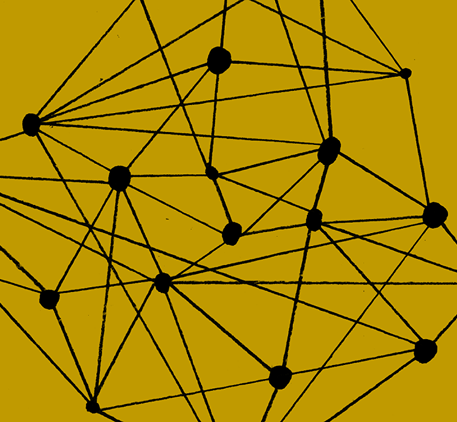‘My Algorithm Has Me In A Chokehold!’: Gen Z, Girl Math and The Thumb Economy
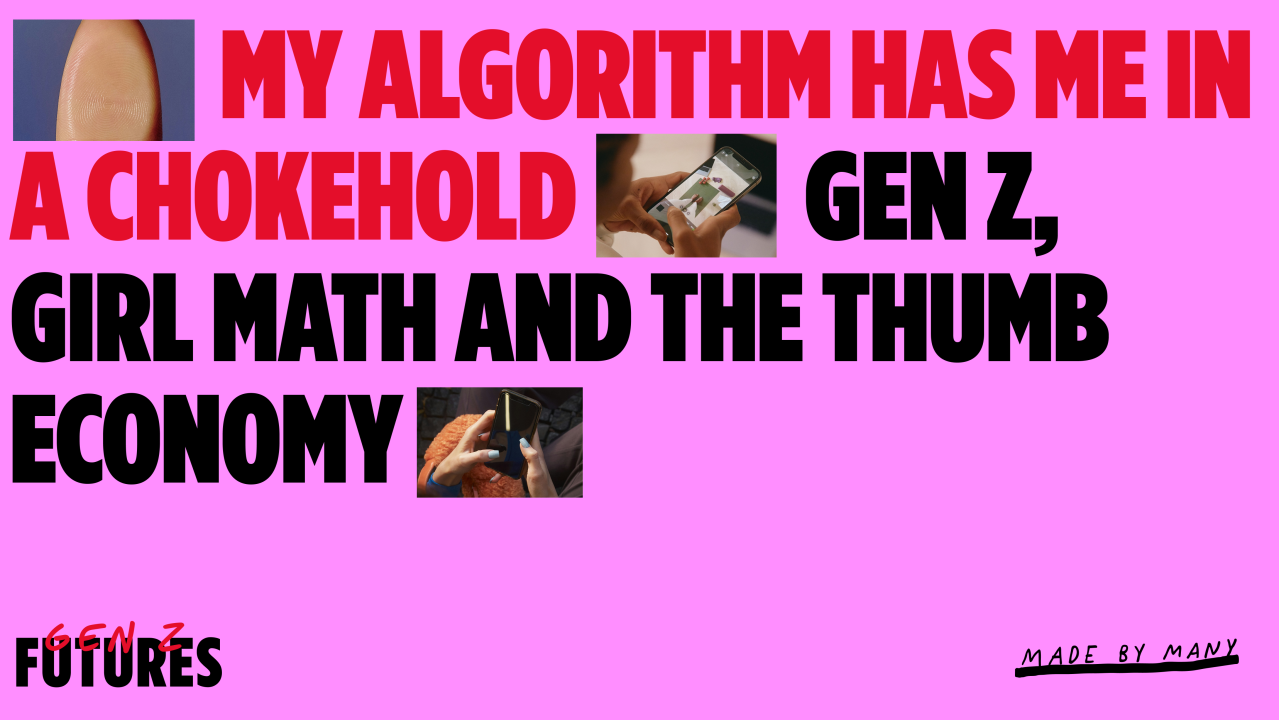
As part of Made by Many’s Gen Z Futures project, our Gen Z collaborators Aarti and Anastasia are unpacking how their generation is redefining industries, from wellness to fun and shopping. Through interviews with peers, research and first-hand insights, they’re exploring what’s changing, what’s next, and what businesses can do to get ahead.
2 AM Purchases and The Scroll; Shop Generation
The moment arrives without warning. I pause mid-scroll, thumb hovering over a pair of shoes that has suddenly taken over my algorithm like an invasive species.
My screen fills with breathless comments: "These changed my life!" "They're cute af, link??". I watch ASMR unboxing videos in rapid succession—the satisfying pull of recycled tissue paper, the pristine soles that have never kissed a pavement, the seemingly genuine joy of someone who's just joined an invisible 'club'. ‘It’s not that deep’, I think to myself. My thumb continues to hover… Boy do I want them. What makes it more enticing is that I could literally have them when I wake up.
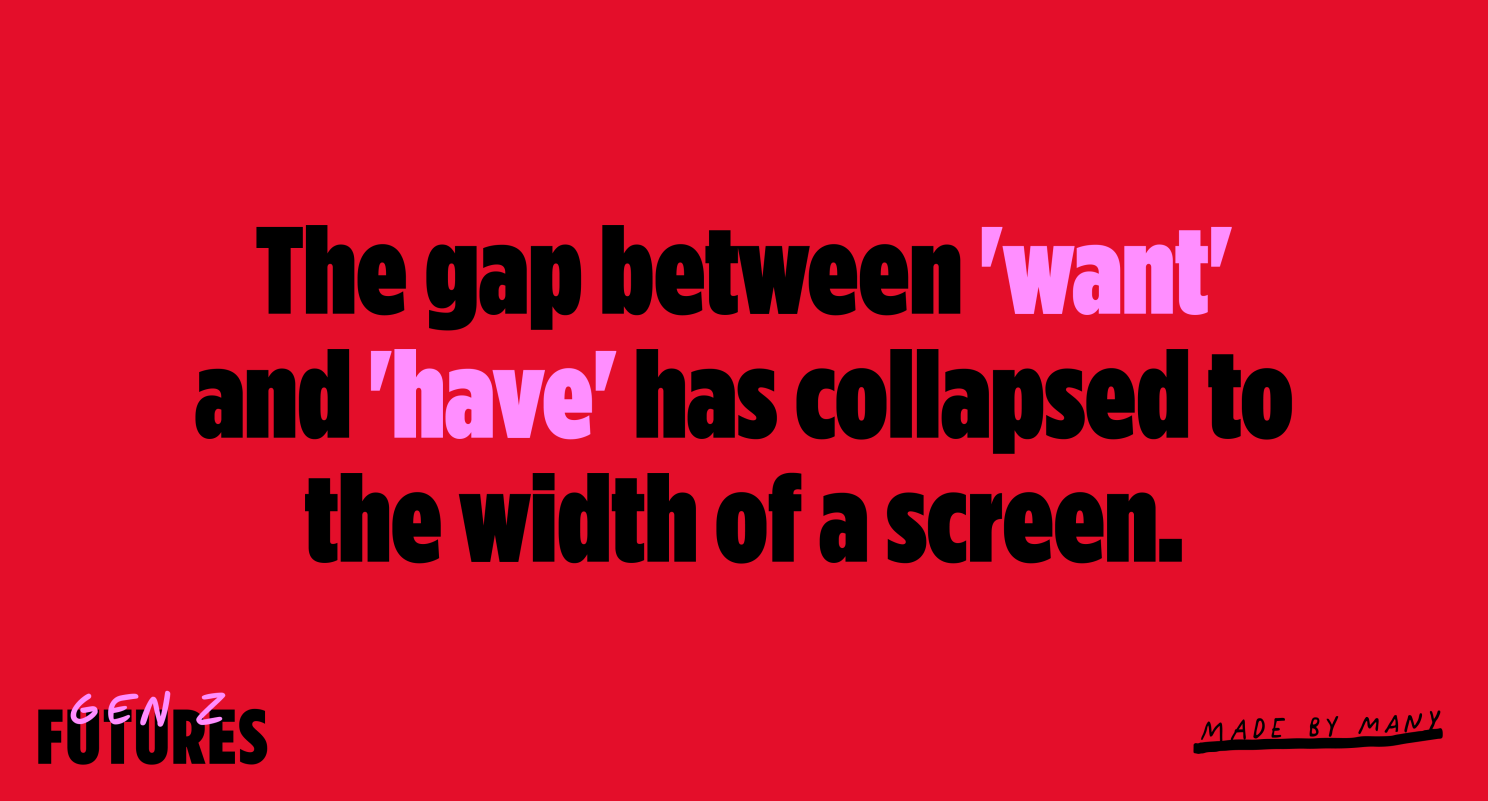
In that micro-second of decision making, an intricate calculus unfolds—one that weighs my bank balance against the intoxicating dopamine bump of knowing I'm only hours from wearing the same shoes my favourite artist just wore on tour. My finger hangs between "Add to Cart" and closing the window.
My banking app peeks at me smugly from the corner of my screen. I've been trying to stick to my monthly budget. Yet something more powerful than financial logic is at work.
Your analytics track this as a conversion metric or abandonment rate. Your marketing decks call it a customer journey.
But what's really happening?
This is a negotiation between who I am, who I want to be, and the version of myself I'm curating for others to witness. We are shopping in the age of the Thumb Economy, where AI reads our minds before we’ve even made it up, influencers are modern day oracles, and algorithms stalk our tastes like thirsty digital bloodhounds.
It's not breaking news that the internet is a weird place. But I think Gen Z truly understands just how weird it is, having been born into its digital embrace and destined to remain entwined with it 'till death do us part' (hopefully not because of it). Alongside Boomers, Gen X, and Millennials, we've witnessed its evolution into an omnipresent, living entity—an uncontrollable digital organism that has permeated every aspect of our existence. It comes as no surprise that this organism can make us do things, like relentlessly shopping for items our algorithms have convinced us we desperately need and transforming casual scrolling into a never-ending parade of potential purchases.
Welcome to the Series on Shopping
The phenomenon of 'social shopping' has fundamentally transformed our relationship with consumption itself, rewiring both our decision-making processes and the complex web of influences that shape our purchasing behaviours. Every tap, like, and share becomes part of an intricate dance between algorithms that predict our wants and communities that validate our choices. The traditional transaction: see product, consider purchase, buy or walk away, has collapsed into a continuous stream of micro-decisions happening in milliseconds as our thumbs hover over "Add to Cart" buttons that seem to follow us everywhere.
I was born in the year 2000, which allocated me in the group Generation Z—affectionately (or with an eye roll) known as Gen Z. Made by Many asked me to write this from my perspective, so here goes. I offer you some respite from tedious agency trend reports and yawny research decks and provide my unvarnished experiences as a member of Gen Z.
In this introductory segment on Shopping, I decode the peculiar alchemy of the way that we shop, haul and swipe our way through this Thumb Economy. From algorithms that seem to read our minds before we’ve made them up, to the financial gymnastics of "Girl Math" that justify our purchases, I will show you how Gen Z cope, create and coexist within a reality that often seems stacked against us.
The Digital Shopping Ecosystem: We Know Our Algos… and Our Algos Know Us
At the center of Gen Z's shopping behaviour is the #TikTokMadeMeBuyIt phenomenon—not just a hashtag but a cultural juggernaut that has spawned over 7 billion posts and counting. This phenomenon, present through different hashtags and across apps (Pinterest, Facebook, Instagram), is an essential part in understanding Gen Z’s shopping ecosystem. From the Stanley Cup (and its endless colours, accessories and dupes) to pastel pink filters for your showerheads to the more niche… bagel guillotines and lighter handbags, it is clear that social media appeals to the unrelenting consumer within us.
This unrelenting consumer is seamlessly woven into our digital existence. Algorithms don't just passively suggest products. Instead, they curate personalised consumer identities.
We are fully aware that every thumb-stopping scroll, double-tap, and share becomes another data point in an increasingly sophisticated feedback loop that anticipates our desires before we've even consciously registered them. The boundaries between entertainment and commerce have dissolved, creating a marketplace where social currency and shopping habits are inextricably linked.
We are living in a time where products are adopted as cultural totems, their value determined not by marketing but through authentic endorsement of peers and creators in an ever-evolving digital community. In this ecosystem, Gen Z are relentlessly consuming not just products but experiences, opinions, and lifestyles that validate their social belonging, and express their identity through purchases that algorithms have invisibly, yet precisely, guided us toward.
It comes as no surprise to me that Gen Z shops on social platforms at a rate four times higher than older generations. We have created a seamless blend between entertainment, social connection, and commerce. The scrolling never stops, and neither does the shopping—participating in everything from skincare routines to DIY hacks to fashion trends… it’s all right at our fingertips for when we want it.
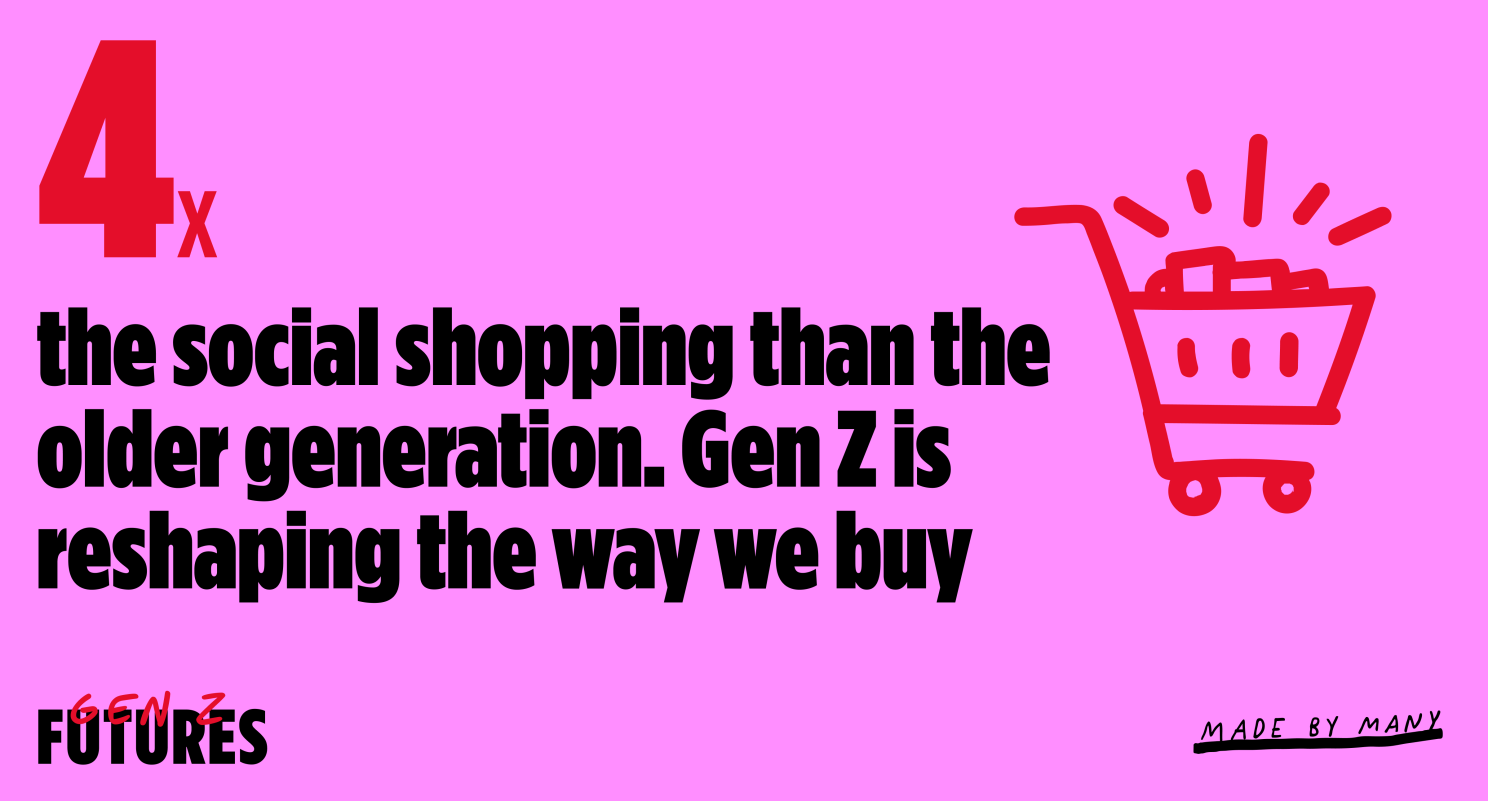
The speed and ease of shopping in this digital world is remarkable. As digital natives, we are wired to navigate the online world effortlessly. We've developed an intimate relationship with the machinery of this landscape and perhaps even feel a closeness with our algorithms—regardless of how queasy some of us might feel about our data being harvested.
There's an eerie sense that we know our algorithms and they know us. Together, we've silently agreed: this is the bargain we're willing to make to customise our digital worlds to our uniquely hybrid identities. I have caught myself saying things like ‘my Instagram algo knows me better than my mom does’, without a hint of irony. Admittedly, it echoes as a sort of Stockholm Syndrome. With this knowledge, do I stop scrolling, liking, and installing more apps? Oh hell no. I have come to terms with the fact that I am in some sort of dance with code: it feeds me and I feed it.
Economic Pressures vs. Social Aspirations: Girl Math & Strategic Splurging
As a member of Gen Z myself, I can say with confidence that for a lot of us, shopping often occurs in a state of financial contradiction. We are simultaneously navigating intense social pressure to participate in consumption-based identity formation while facing our own unique financial realities.

Enter Girl Math: a whimsical financial logic that has become an ironic coping mechanism for consumption guilt. For those uninitiated with Gen Z’s new social language, Girl Math is not abacus for females, if that’s what you were thinking (Ok, Boomer). Instead, it is a method popularised by women on social media that wraps humour around economic anxiety. It works in the following ways:
Something is on sale? You're making money on those savings. Paid in cash? Congratulations, it never happened to your bank account, so it's basically free. That dress with the obscene price tag? When you divide it by the 50 times you'll wear it over five years, it costs less per use than your morning latte (which you'll heroically skip on dress-wearing days). And that return from two weeks ago that just hit your account? That's not your money coming back, that's fresh income, baby!
I know there are some Boomers out there sighing at this attempt to justify what they see as frivolous spending. What I invite them to see is that beneath the fun and irony, lies something more profound: a collective understanding that traditional financial advice doesn't always map onto our economic realities. When housing seems perpetually out of reach and student loans loom large for our generation, the momentary joy of a strategic purchase becomes not just understandable but perhaps even necessary—a small claim to pleasure in an uncertain economic landscape.
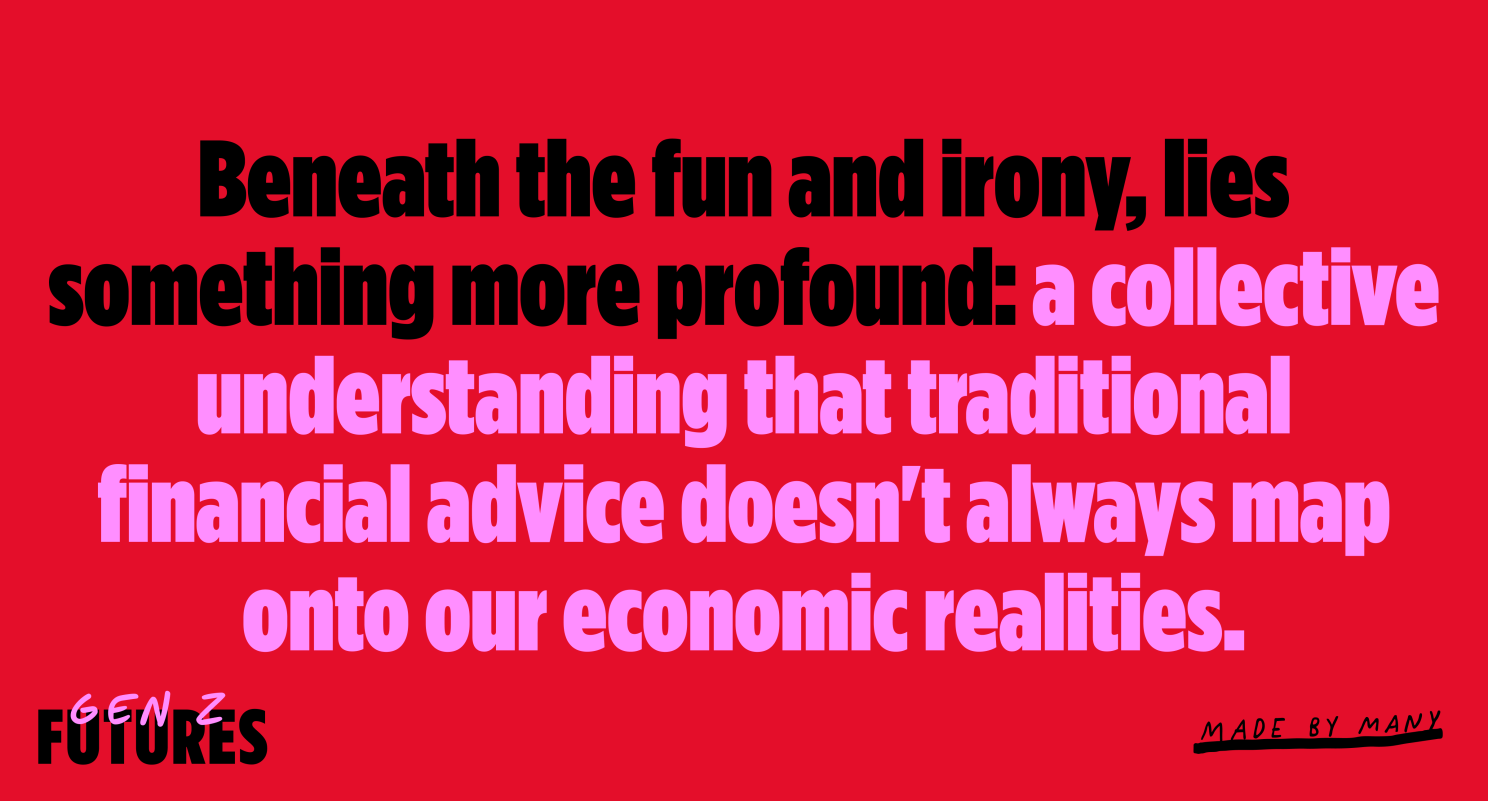
So, despite the "Cozzie Livs" ( cost of living crisis), this dynamic explains why, despite the majority of us changing our spending habits due to rising prices, we're still finding ways to participate in key consumption moments. The result isn't reduced spending but redirected spending—we're making intentional choices about where to invest our limited resources for maximum "social" return. When the big financial milestones our parents took for granted seem increasingly like fantasies to us, Gen Z has become good at finding small, accessible ways to experience and connect through consumption in ways that feel meaningful to us.
From Marketing to Making
As I navigate this Thumb Economy, one thing becomes clear: Gen Z are disrupting consumer markets and reinventing it through the power of online communities. You may be right when you say our algorithms hold our attention hostage. But what you may not see is that within this same digital environment, we have found unprecedented freedom to reshape what consumption means and in turn, see just how far innovation can go.
The beauty of being Gen Z in this moment is that we understand the ‘game’ being played. Unlike previous generations who either feared technology or embraced it uncritically, Gen Z has developed a nuanced relationship with digital systems that both control and empower us. We see our algorithms tracking our every move, but we're using those same systems to amplify our collective voice. When we rally behind small creators, hunt for dupes, or turn shopping hauls into content, we're not just spending time and money, we're declaring what matters to us and what doesn't.
So yes, my algorithm might have me in a chokehold sometimes. But as I move between "Add to Cart" and closing the app, I am part of the reshaping of what it means to consume, connect, and create value in this digital age. You can say we are redefining what it means to belong, express, and truly matter in a world that's still learning to speak our language.
Throughout this series, I'll open up various windows into Gen Z’s thinking—exploring how we navigate financial contradictions, build communities around consumption, and find meaning through purchases in ways previous generations might find puzzling. I’m no CMO, but here’s my 2p: When Gen Z's shopping behaviours become the norm rather than the exception, expect to see the collapse of traditional marketing funnels and the rise of community-authenticated commerce. The Thumb Economy isn't just changing how we shop, it's fundamentally altering the relationship between identity, community, and consumption in ways that will eventually transform every industry touched by desire.


